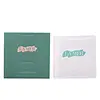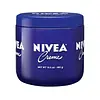La Mer The Hydrating Facial Versus Nivea Crème
What's inside
What's inside
 Key Ingredients
Key Ingredients

No key ingredients
 Benefits
Benefits

 Concerns
Concerns

 Ingredients Side-by-side
Ingredients Side-by-side

Triethylhexanoin
MaskingSimmondsia Chinensis Seed Oil
EmollientGlycerin
HumectantSqualane
EmollientStearic Acid
CleansingBatyl Alcohol
EmollientAlgae Extract
EmollientSesamum Indicum Seed Oil
EmollientMedicago Sativa Seed Powder
Skin ConditioningHelianthus Annuus Seedcake
AbrasivePrunus Amygdalus Dulcis Seed Meal
AbrasiveEucalyptus Globulus Leaf Oil
PerfumingSodium Gluconate
Skin ConditioningCopper Gluconate
Skin ConditioningCalcium Gluconate
HumectantMagnesium Gluconate
Skin ConditioningZinc Gluconate
Skin ConditioningTocopheryl Succinate
AntioxidantNiacin
SmoothingSesamum Indicum Seed Powder
Skin ConditioningOryza Sativa Bran Extract
Skin ConditioningCucumis Melo Fruit Extract
Skin ConditioningOlea Europaea Fruit Extract
BleachingPorphyridium Cruentum Extract
Skin ConditioningPolygonum Cuspidatum Root Extract
AntioxidantSaccharomyces Lysate Extract
HumectantAscophyllum Nodosum Extract
Skin ConditioningPersea Gratissima Oil
Skin ConditioningGarcinia Indica Seed Butter
Skin ConditioningCaffeine
Skin ConditioningAsparagopsis Armata Extract
Skin ProtectingCodium Tomentosum Extract
Skin ProtectingLactobacillus Ferment
Skin ConditioningLaminaria Ochroleuca Extract
Skin ConditioningGlycine Soja Seed Extract
Skin ConditioningPunica Granatum Fruit Juice
MaskingThermus Thermophillus Ferment
Skin ConditioningUndaria Pinnatifida Extract
Skin ConditioningCreatine
Skin ConditioningHydrogenated Lecithin
EmulsifyingSorbitol
HumectantEthylhexylglycerin
Skin ConditioningCaprylic/Capric Triglyceride
MaskingLecithin
EmollientPhytantriol
HumectantTourmaline
Dimethicone
EmollientTrehalose
HumectantPotassium Hydroxide
BufferingPropylene Glycol Dicaprylate
EmollientGlycosaminoglycans
EmollientButylene Glycol
HumectantYeast Extract
Skin ConditioningCholesterol
EmollientAcrylates/C10-30 Alkyl Acrylate Crosspolymer
Emulsion StabilisingPotassium Sulfate
Sodium Hyaluronate
HumectantSaccharomyces Ferment Lysate Filtrate
Skin ConditioningPEG-100 Stearate
Pentylene Glycol
Skin ConditioningXanthan Gum
EmulsifyingHydroxypropyl Cyclodextrin
MaskingParfum
MaskingDisodium EDTA
Hydroxycitronellal
PerfumingCitronellol
PerfumingLinalool
PerfumingGeraniol
PerfumingLimonene
PerfumingPhenoxyethanol
PreservativeTriethylhexanoin, Simmondsia Chinensis Seed Oil, Glycerin, Squalane, Stearic Acid, Batyl Alcohol, Algae Extract, Sesamum Indicum Seed Oil, Medicago Sativa Seed Powder, Helianthus Annuus Seedcake, Prunus Amygdalus Dulcis Seed Meal, Eucalyptus Globulus Leaf Oil, Sodium Gluconate, Copper Gluconate, Calcium Gluconate, Magnesium Gluconate, Zinc Gluconate, Tocopheryl Succinate, Niacin, Sesamum Indicum Seed Powder, Oryza Sativa Bran Extract, Cucumis Melo Fruit Extract, Olea Europaea Fruit Extract, Porphyridium Cruentum Extract, Polygonum Cuspidatum Root Extract, Saccharomyces Lysate Extract, Ascophyllum Nodosum Extract, Persea Gratissima Oil, Garcinia Indica Seed Butter, Caffeine, Asparagopsis Armata Extract, Codium Tomentosum Extract, Lactobacillus Ferment, Laminaria Ochroleuca Extract, Glycine Soja Seed Extract, Punica Granatum Fruit Juice, Thermus Thermophillus Ferment, Undaria Pinnatifida Extract, Creatine, Hydrogenated Lecithin, Sorbitol, Ethylhexylglycerin, Caprylic/Capric Triglyceride, Lecithin, Phytantriol, Tourmaline, Dimethicone, Trehalose, Potassium Hydroxide, Propylene Glycol Dicaprylate, Glycosaminoglycans, Butylene Glycol, Yeast Extract, Cholesterol, Acrylates/C10-30 Alkyl Acrylate Crosspolymer, Potassium Sulfate, Sodium Hyaluronate, Saccharomyces Ferment Lysate Filtrate, PEG-100 Stearate, Pentylene Glycol, Xanthan Gum, Hydroxypropyl Cyclodextrin, Parfum, Disodium EDTA, Hydroxycitronellal, Citronellol, Linalool, Geraniol, Limonene, Phenoxyethanol
 Reviews
Reviews

Alternatives
Ingredients Explained
These ingredients are found in both products.
Ingredients higher up in an ingredient list are typically present in a larger amount.
Glycerin is already naturally found in your skin. It helps moisturize and protect your skin.
A study from 2016 found glycerin to be more effective as a humectant than AHAs and hyaluronic acid.
As a humectant, it helps the skin stay hydrated by pulling moisture to your skin. The low molecular weight of glycerin allows it to pull moisture into the deeper layers of your skin.
Hydrated skin improves your skin barrier; Your skin barrier helps protect against irritants and bacteria.
Glycerin has also been found to have antimicrobial and antiviral properties. Due to these properties, glycerin is often used in wound and burn treatments.
In cosmetics, glycerin is usually derived from plants such as soybean or palm. However, it can also be sourced from animals, such as tallow or animal fat.
This ingredient is organic, colorless, odorless, and non-toxic.
Glycerin is the name for this ingredient in American English. British English uses Glycerol/Glycerine.
Learn more about GlycerinParfum is a catch-all term for an ingredient or more that is used to give a scent to products.
Also called "fragrance", this ingredient can be a blend of hundreds of chemicals or plant oils. This means every product with "fragrance" or "parfum" in the ingredients list is a different mixture.
For instance, Habanolide is a proprietary trade name for a specific aroma chemical. When used as a fragrance ingredient in cosmetics, most aroma chemicals fall under the broad labeling category of “FRAGRANCE” or “PARFUM” according to EU and US regulations.
The term 'parfum' or 'fragrance' is not regulated in many countries. In many cases, it is up to the brand to define this term.
For instance, many brands choose to label themselves as "fragrance-free" because they are not using synthetic fragrances. However, their products may still contain ingredients such as essential oils that are considered a fragrance by INCI standards.
One example is Calendula flower extract. Calendula is an essential oil that still imparts a scent or 'fragrance'.
Depending on the blend, the ingredients in the mixture can cause allergies and sensitivities on the skin. Some ingredients that are known EU allergens include linalool and citronellol.
Parfum can also be used to mask or cover an unpleasant scent.
The bottom line is: not all fragrances/parfum/ingredients are created equally. If you are worried about fragrances, we recommend taking a closer look at an ingredient. And of course, we always recommend speaking with a professional.
Learn more about Parfum